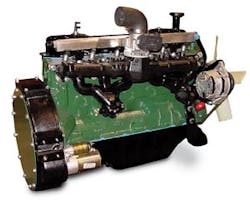By Joe Lewis, vice president of engine sales, HEC
For many years there has been lots of discussion regarding implementing the use of hydrogen as a transportation fuel. Both the Department of Transportation and the Environmental Protection Agency recognize the importance of using this carbonless and non-polluting fuel to reduce greenhouse gas and other harmful exhaust emissions associated with the use of internal combustion engines.
To date, the main obstacle in the way of using hydrogen as a fuel has to do with its density and the ability to store it. When compared to other traditional carbon-based fuels, hydrogen is the hands-down winner when it comes to issues associated with emissions. However, when it is compared with these same fuels on other issues such as ease of handling, energy density “as a gas,” storability and cost, hydrogen doesn’t fare so well. A comparison I like to use when talking to people is this: Take a cubic foot and fill it with gasoline and then put it in your car. Depending on your fuel economy, it’s safe to say that most cars could use that fuel to travel a distance equal to going from Chicago to Indianapolis. Take that same cubic foot and fill it with gaseous hydrogen at atmospheric pressure and you would most likely not make it out of your driveway.
In order to obtain any type of range out of a hydrogen-fueled vehicle, the issue of storage must be overcome. Today there are several companies that offer storage solutions that include high-pressure cylinders that store the fuel in a gaseous state. Depending on the required range of a vehicle or piece of equipment, hydrogen can be stored this way at pressures up to 10,000 psi. Another way to store hydrogen in great volume is to do so cryogenically at temperatures below 252 degrees Celcius, where it turns into a dense liquid. The problem here is the amount of energy required to keep it in a liquid state and the cost of the storage tank. Other newer technologies include metal-hydride storage tanks. These show great promise in the area of improved storage density at lower pressures than as a gas.
So where are the big opportunities for hydrogen? The ideal close term market to realize a hydrogen economy could be at an airport near you. Ground support vehicles represent a huge opportunity for any large airport to greatly lower their overall carbon footprint by implementing the use of hydrogen. Many of the problems associated with the use of hydrogen for highway vehicle transportation simply do not exist at airports. Most GSE uses a centralized fueling depo for their fleets, range is not nearly as big an issue and technology to retrofit existing spark-ignited engines with hydrogen versions is available today.
The next question is where does the hydrogen come from to run the fleet? Current sources of hydrogen include purchasing it from local gas supply companies as well as making it onsite using a large scale commercial electrolyzer. An electrolyzer uses electrical current to unbind the oxygen and hydrogen molecules that make up water. The hydrogen would then be stored in a large-volume and high-pressure storage system for later dispersment at a nearby fueling station. A technology to watch out for would be the use of a plasma reactor. This concept uses high-temperature plasma to convert waste products like garbage, oils, tires, batteries and all types of materials that are otherwise headed for land fills or recycling centers and into syngas. The syngas can then be converted into near pure hydrogen. This model takes and converts both toxic and non-toxic waste into the cleanest of energy sources, “hydrogen.” A large-scale system could handle all of the waste from a major airport such as LAX and convert it into possibly enough fuel to run the entire ground support fleet there.
The engine shown here is a hydrogen fueled Oxx Power 4.9L model produced by Hydrogen Engine Center. The engine is a direct retrofit for existing Ford 300s currently used in GSE service today and will run on pure hydrogen as well as blends using natural gas or propane. Stay tuned for more about this hot topic in the March issue.





